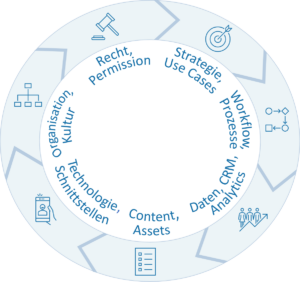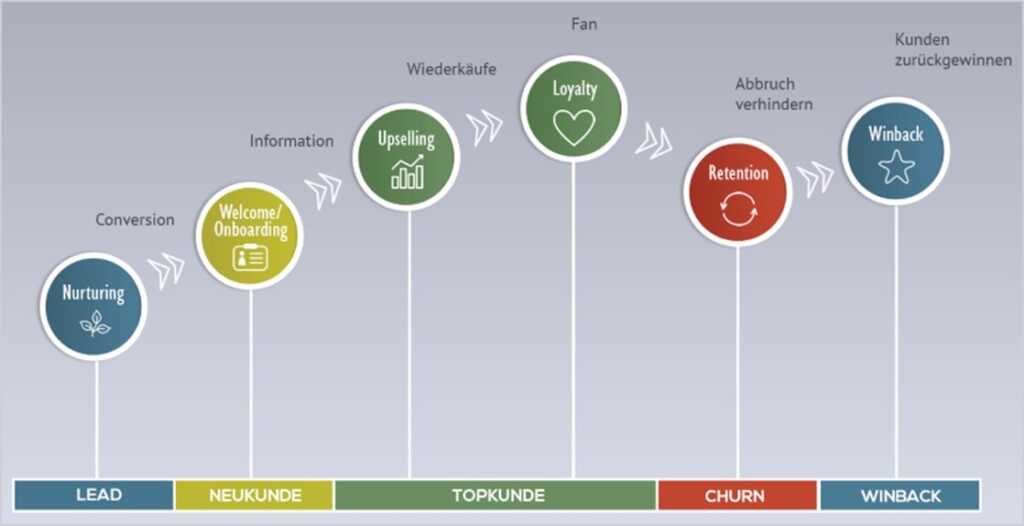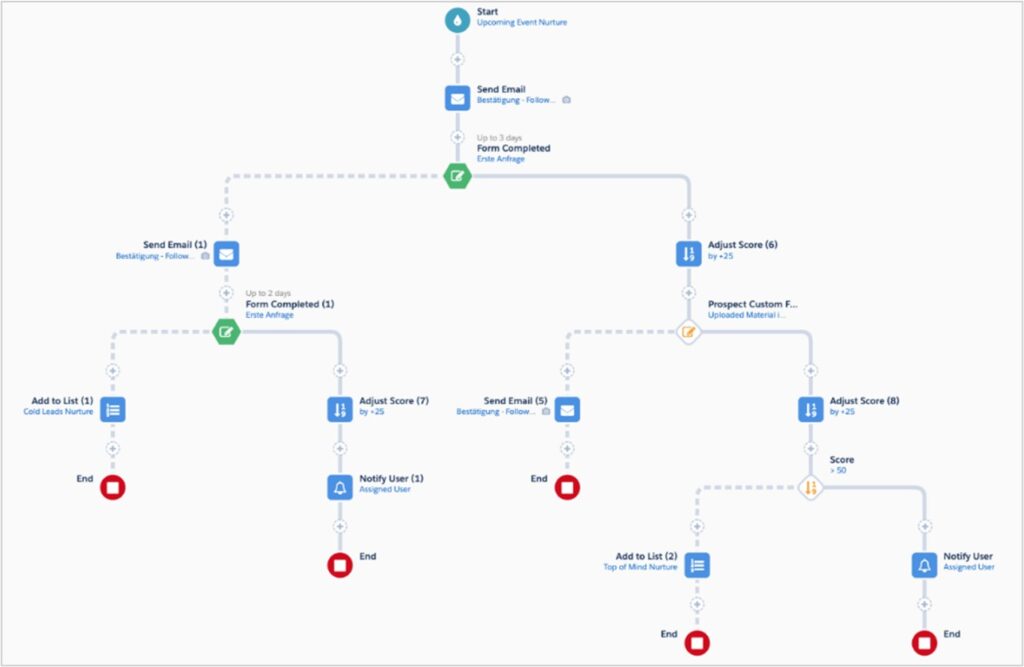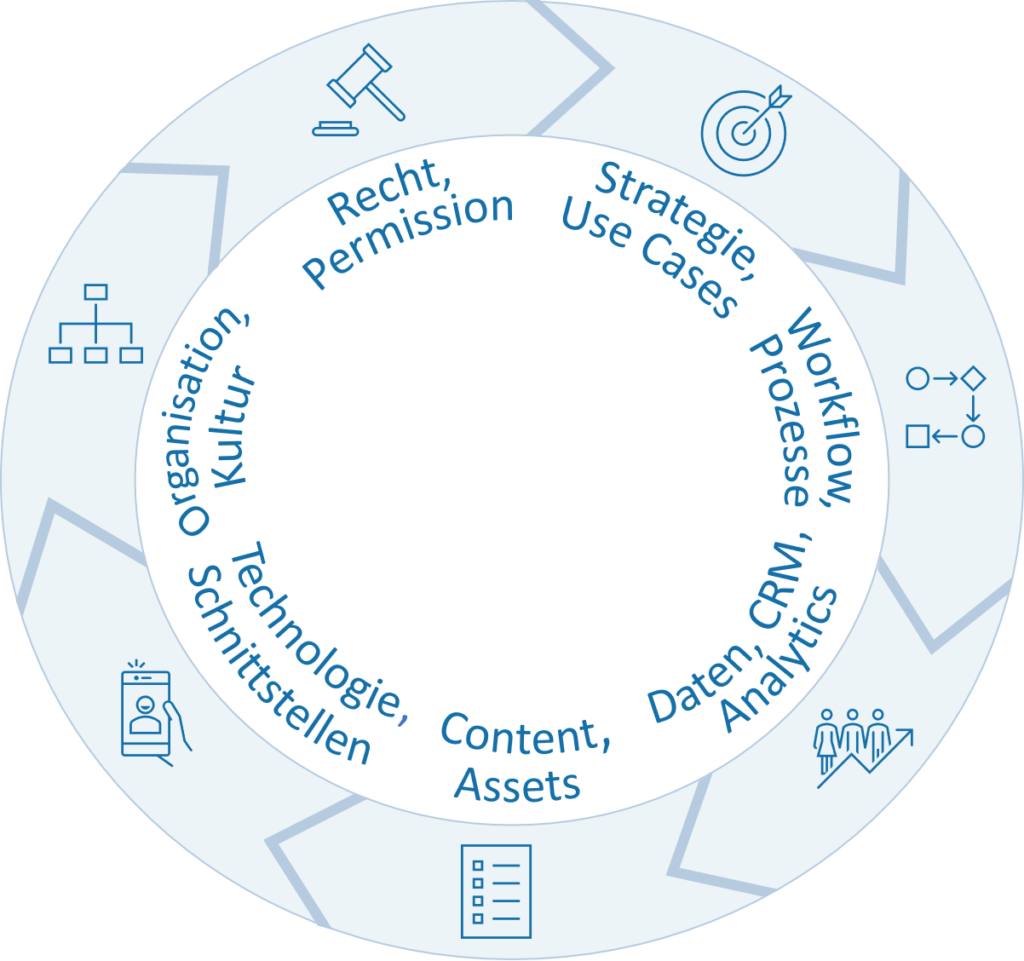Marketing AutomationMarketing Automation ist ein Framework bestehende aus Strategie (First Party Data und Marketing), Use Cases und Prozessen, Daten bzw. Customer Data Platform, Technologien, Inhalten, Organisation und Skills sowie dem Rechtsrahmen bzw. dem Consent Management.... – Technological Wonder Weapon or New Mindset for Effective, Customer-Centric Marketing and More Sales – Part 1
The automation of customer approach and of processes in marketing and sales can be found in all disciplines of digital marketing. This article attempts to break down a big buzzword into its component parts and thus reduce the task to a feasible level; but also to point out that some homework has to be done before you plunge into the adventure of automation in the long term. In addition, the article aims to provide concrete recommendations for action at various touchpoints of the customer journey, but also on the way to effective automation. Use cases show how to get started easily without losing sight of the big picture on a journey lasting several years.
The focus of the user approach is usually on e-mail, which is ideally suited for automation due to its characteristics. In addition, if there is inactivity on this channel, retargeting (personalized targeting via display advertising based on user behavior) and audience matching (new customer identification based on the user behavior of known target groups) can be used to target alternative and complementary digital channels in the direction of omnichannel marketing.
One thing is clear, but is often seen far too narrowly: Marketing AutomationMarketing Automation ist ein Framework bestehende aus Strategie (First Party Data und Marketing), Use Cases und Prozessen, Daten bzw. Customer Data Platform, Technologien, Inhalten, Organisation und Skills sowie dem Rechtsrahmen bzw. dem Consent Management.... is not a technology, but rather a mindset and a kit that is part of a marketing and sales strategy. The following modules and components of automation are examined in detail:
- Strategy for marketing automationMarketing Automation ist ein Framework bestehende aus Strategie (First Party Data und Marketing), Use Cases und Prozessen, Daten bzw. Customer Data Platform, Technologien, Inhalten, Organisation und Skills sowie dem Rechtsrahmen bzw. dem Consent Management.... in new customer business as well as in existing customer marketing; i.e., analysis of touchpoints and identification of triggers along the customer journey for possible use cases to specific groups of recipients via specific (digital) channels
- Processes for automation flow based on events, actions, conditions and turnoffs
- Content as a connecting and meaningful element along automation
- (Un)structured data in targeted use along a process to be modeled
- Technologies and surrounding systems for the implementation, control and flow of workflows as well as for the measurement and evaluation of results
- Adaptations of skills at the staff, at the company organization and in cooperation with specialized consultants
- Legal requirements as a prerequisite for the implementation of automation
This leads to the definition of marketing automationMarketing Automation ist ein Framework bestehende aus Strategie (First Party Data und Marketing), Use Cases und Prozessen, Daten bzw. Customer Data Platform, Technologien, Inhalten, Organisation und Skills sowie dem Rechtsrahmen bzw. dem Consent Management..... The topic is naturally controlled by the countless technology providers in the market, who present their communicative dream castles along the customer journey. “A fool with a tool is still a fool”, this truth applies not only but even more so since Marketing AutomationMarketing Automation ist ein Framework bestehende aus Strategie (First Party Data und Marketing), Use Cases und Prozessen, Daten bzw. Customer Data Platform, Technologien, Inhalten, Organisation und Skills sowie dem Rechtsrahmen bzw. dem Consent Management..... For the conversion of as many leads as possible into new customers, the basic application of automation, generous budgets and investments are spoken for such technologies. But there is much more to it.
In the following, the individual components of Marketing AutomationMarketing Automation ist ein Framework bestehende aus Strategie (First Party Data und Marketing), Use Cases und Prozessen, Daten bzw. Customer Data Platform, Technologien, Inhalten, Organisation und Skills sowie dem Rechtsrahmen bzw. dem Consent Management.... (according to this figure) are explained and their importance for the interdisciplinary whole is shown.

Strategy and Use Cases:
It is well known that the many touchpoints along the customer journey offer countless opportunities for customer interactions, recipient campaigns and workflow-driven targeting of leads and customers. Those who equate marketing automationMarketing Automation ist ein Framework bestehende aus Strategie (First Party Data und Marketing), Use Cases und Prozessen, Daten bzw. Customer Data Platform, Technologien, Inhalten, Organisation und Skills sowie dem Rechtsrahmen bzw. dem Consent Management.... with lead generation and lead nurturing, i.e. the systematic process of converting contacts into customers via a sales funnel through a multi-stage communication and sales process, are missing out on many opportunities. In any case, it is worthwhile to identify triggers in a workshop which you want to activate strategically for the goals of the customer approach.
Such triggers may include:
- The lead who, as a result of inbound marketing, identifies himself as an interested party by filling out a form (e.g. newsletter registration) or a download (whitepaper, how-to document) via his e-mail address. This lead is now ideally addressed via multiple channels and built up via their click behavior and a built-in scoring system. If the score is high enough, the lead is passed to sales and converted to a customer via a specialist. Automation helps here to control and condense the process and to qualify the conversion probability in a resource-saving way.
- The much-quoted abandonment of the sales process is taken as an opportunity to make good on this omission and persuade the customer to close after all; a good single-digit increase in the conversion rate is guaranteed in many cases.
- The first point of contact, a simple welcome cycle as part of the nurturing process, is an attempt to charge a contact at the moment of greatest interest with information about the company, its values and differentiators, the benefits of products and services, before inviting them to take action to buy. Timely and benefit-focused interaction is important here.
- A customer’s birthday or customer anniversary in the company’s database are simple but still very effective triggers.
- Digital onboarding saves the company the labor-intensive or paper-wasting interaction with the new customer, especially for products or services that require explanation.
- The act of purchase or purchase confirmation can be the trigger for an upselling process in order to offer the customer accessories or a service subscription, to encourage him to rate the product or to recommend it to others.
- In the case of consumables, the customer can be persuaded to make a repeat purchase or to sign up for a regular service after a certain period of time.
- In the case of bonus programs, a customer can be specifically notified when he is about to reach a certain points threshold, which makes him even more loyal or offers him additional opportunities for use.
Emails based on such triggers contain a specific selection, are more relevant and therefore have open rates of +/- 50%, which is twice to three times higher than regular newsletters. The second important aspect is specific targeting measures. This requires data from ERP and/or CRM. It is mainly a matter of finding target groups that can be written to in a targeted manner using automatic measures.
The following customer groups or personas are suitable:
- The one-shot customer, with the goal of motivating him to make a second purchase.
- The rising star, with the goal of increasing sales and making him loyal.
- The stationary customer with the goal of motivating him to buy online.
- The customer, predominantly buying from the competition, with the goal of converting him in the long term.
- The churn customer with the goal of retaining the customer.
- The inactive customer with the goal of reactivation.
Such target groups can be calculated manually or measures can be triggered automatically when certain threshold values are reached or criteria are met. In any case, these target groups are based on use cases, which are defined as a project and played out as an automated process.
In addition to these predominantly quantitative goals in new customer and existing customer marketing, there are other objectives such as increasing customer engagement, increasing productivity, or simply improving the measurability of campaigns.
This overview is intended to help define marketing goals, set priorities and deploy resources as efficiently as possible. This classic homework also applies to digital marketing and is more important than succumbing to the operational frenzy that erupts when a consultant arrives on the scene with a new technology or groundbreaking measures. A fool with a tool and possibly a new methodology remains a fool without objectives and targets.
Of course, targeting measures can also be found in paid marketing, where the anonymous contact is served advertising based on his attributes via various publishers or via Google search. This is also automated. However, it will not be discussed further in this article. However, the surfing behavior becomes relevant as a starting point for a campaign if the anonymous user has deposited his e-mail address. Now his behavior can be used specifically in the context of lead nurturing; “permission” provided (see chapter Legal).

Recommendations:
- Get smart about what marketing automationMarketing Automation ist ein Framework bestehende aus Strategie (First Party Data und Marketing), Use Cases und Prozessen, Daten bzw. Customer Data Platform, Technologien, Inhalten, Organisation und Skills sowie dem Rechtsrahmen bzw. dem Consent Management.... means holistically and don’t just think about technology. No one will take strategy off your hands.
- Conduct a discovery workshop with marketing, sales and IT (if available with data analysts). Identify a few touchpoints, define a few use cases.
- Don’t forget the big picture (collecting data, scalable technology), but start small with “quick wins”, gain experience, optimize and venture into bigger use cases and more complicated data analysis.
In the “good” old analog and early digital days, there were still manageable, mostly manual campaigns. These had clear, simple goals and processes. Increasing relevance based on specific user behavior and personalizing the measures were not possible. At the end, people considered whether they had served their purpose and, if they had been successful, whether they would be repeated from time to time.
With automation, this changes fundamentally. All of the above activities based on triggers and in terms of targeting strategies require the definition and design of a process with the sequence of event (trigger), conditions, actions, branches and content in different, relevant and personalized steps. The process changes when a user behaves in a certain way, for example, when opening a mail, reading a certain content, or when a purchase has been made, although the planned process is not yet over; or when a certain scoring value is reached. Time can also play a role in not overwhelming the user with too many mails. Further communication vessels to the same user can collide with an automated process. This is where so-called cadence management is required.
This process has to be clearly defined in terms of time, action and content. Whereas manual intervention and manual activities used to be required at every branch, the marketing specialist thinks about what has to happen when a certain action (does not) occur. As a result, target groups become more specific, content becomes more relevant, and targeting is more personalized. This requires a consistent analytical mindset. The marketing engineer is born or he just falls by the wayside if he is not given this way of thinking or if he does not have a business analyst at hand who accompanies him through the process variations and enlivens all branches with actions. The potential is not hard to see. At the same time, however, it is clear how much time and planning is required to set up the core process for the first time.

Thanks to process thinking, the marketer is forced to consistently play through marketing processes, to perceive new options and to adapt existing ones. Manual actions can be saved and related errors reduced. Existing resources are used more intelligently, namely for the development of new cycles and for the measurement and improvement of campaign performance.
In this way, automation is constantly evolving and does not simply end with the completion of a process. It is a good idea to comb through the entire customer lifecycle and consider which triggers and target groups can be used to set up suitable processes. This approach is already well advanced in successful eCommerce companies.
Recommendations:
- Don’t define complicated processes at the very beginning. Start simple and learn. A birthday mail has exactly one start, one process step and one end, to one person: a mailing on the birthday or maybe as a pre-mailing some time before.
- The process wants to be modeled: a trigger is an event as a starting point for the whole process, conditions control it, actions and branches are triggered by user behavior. Time blockers pause the process, business rules define it. It depends on the goals and user behavior. When you start, it becomes analytical, but now automation starts to make real sense and even more fun.
- Introduce quick wins, learn, optimize, collect more data (see chapter Data), continuously define new use cases and segment more and more filigree. Automation is a permanent learning process.


